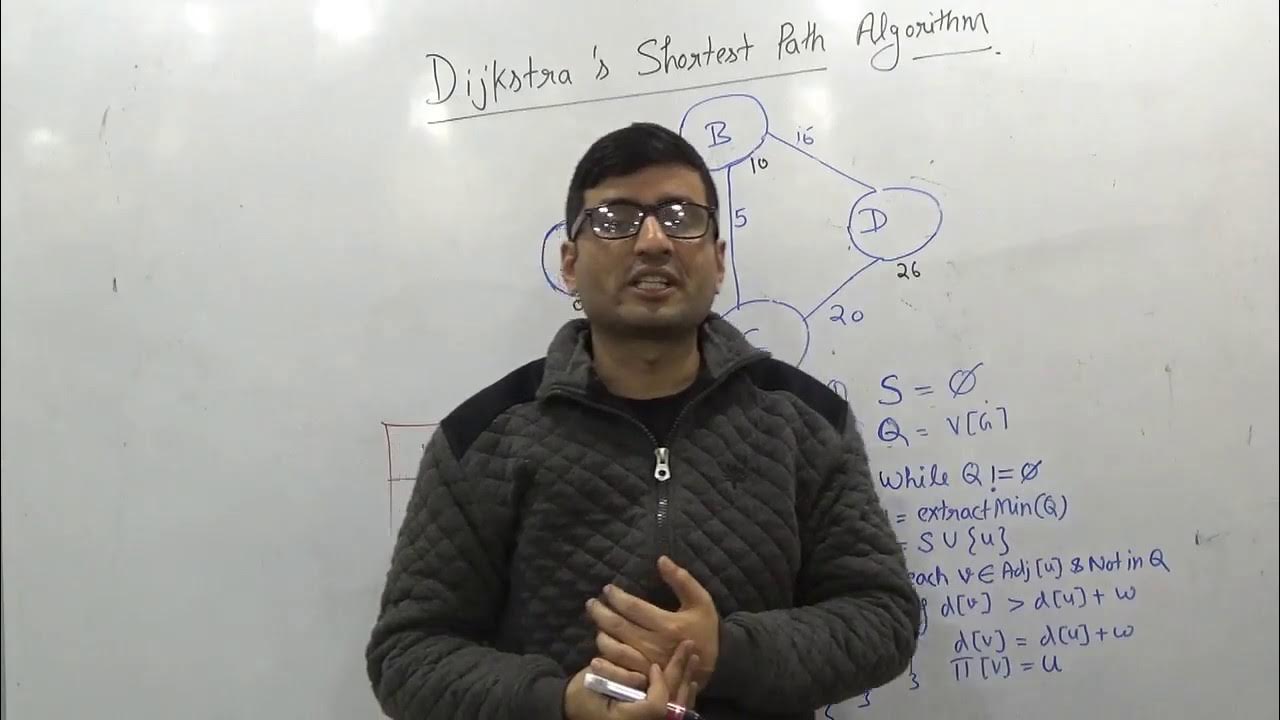L-4.13: Bellman Ford Algorithm | Dijkstra's Vs Bellman Ford | Single Source Shortest Path
Summary
TLDRIn this video, the Bellman-Ford algorithm is explained in detail, with comparisons to Dijkstra's algorithm. The key differences, such as Bellman-Ford's ability to handle negative weight cycles and its relaxation process (repeated V-1 times), are highlighted. The video breaks down the algorithm's steps through examples, showing how it finds the shortest path and detects negative edge cycles. The tutorial provides clear explanations and practical insights, ensuring students understand the algorithm's mechanics and its application, preparing them for exams and interviews.
Takeaways
- 😀 The Bellman-Ford algorithm differs from Dijkstra's algorithm in that it relaxes every edge 'V-1' times, where V is the number of vertices.
- 😀 Dijkstra's algorithm stops after relaxing edges once, potentially missing shorter paths, while Bellman-Ford handles negative weight cycles and finds the correct shortest paths.
- 😀 In Dijkstra’s algorithm, once a node's shortest path is found, it is fixed, but in Bellman-Ford, the algorithm continues relaxing edges to ensure optimal results.
- 😀 The Bellman-Ford algorithm uses the concept of relaxing each edge multiple times (V-1 times) to find the shortest paths, even in graphs with negative weights.
- 😀 When applying Bellman-Ford, you first initialize distances as infinity (except for the source), and then iteratively relax edges to update distances.
- 😀 The algorithm checks for negative weight cycles by running an additional relaxation step after V-1 iterations. If any distance decreases, it indicates a negative cycle.
- 😀 Bellman-Ford guarantees finding the shortest path in graphs with negative weights, while Dijkstra’s algorithm is not effective in such cases.
- 😀 A key difference is that Bellman-Ford continues relaxing edges for a set number of times (V-1), while Dijkstra’s algorithm halts after one pass through the nodes.
- 😀 The second relaxation step in Bellman-Ford helps ensure no shorter path is overlooked, even if the first pass found an optimal path.
- 😀 By relaxing all edges twice (V-1 times), Bellman-Ford handles negative edge cycles by detecting changes in distances after the final relaxation, signaling a cycle.
Q & A
What is the main difference between the Dijkstra and Bellman-Ford algorithms?
-The main difference is that Dijkstra's algorithm works by greedily choosing the nearest node, whereas Bellman-Ford relaxes every edge V-1 times to find the shortest path, ensuring it can handle graphs with negative edge weights and detect negative weight cycles.
How does Dijkstra's algorithm work in comparison to Bellman-Ford when encountering a graph with negative weights?
-Dijkstra’s algorithm fails to find the correct shortest path in graphs with negative edge weights, as it does not recheck edges once a node’s distance is fixed. In contrast, Bellman-Ford can handle negative edge weights and finds the correct shortest path by relaxing all edges multiple times.
What does it mean to 'relax' an edge in the Bellman-Ford algorithm?
-Relaxing an edge means updating the shortest known distance to a vertex if a shorter path is found by traversing that edge.
Why does Bellman-Ford relax edges V-1 times, and what does this help achieve?
-Bellman-Ford relaxes edges V-1 times to ensure the shortest path is found for all nodes, as the longest possible path in a graph with V vertices will involve V-1 edges. This process also helps detect negative weight cycles.
What is the time complexity of the Bellman-Ford algorithm?
-The time complexity of the Bellman-Ford algorithm is O(V * E), where V is the number of vertices and E is the number of edges in the graph.
How can Bellman-Ford detect negative weight cycles?
-Bellman-Ford detects negative weight cycles by performing one additional relaxation after the V-1 relaxations. If any edge can still be relaxed, it indicates the presence of a negative weight cycle.
In the example discussed, why does Dijkstra's algorithm fail to find the correct shortest path from A to C?
-Dijkstra's algorithm fails to find the correct shortest path from A to C because it fixes the distance of nodes too early. In this case, it stops at a distance of 5, not accounting for the shorter path that could be found through node B.
What does the Bellman-Ford algorithm do when it finds that an edge can still be relaxed after V-1 relaxations?
-When Bellman-Ford finds that an edge can still be relaxed after V-1 relaxations, it indicates the presence of a negative weight cycle, and the algorithm reports this to prevent further incorrect results.
Can Bellman-Ford handle graphs with both positive and negative edge weights?
-Yes, Bellman-Ford can handle graphs with both positive and negative edge weights. It is particularly useful in graphs with negative weight edges, unlike Dijkstra’s algorithm.
Why is it important to relax every edge in Bellman-Ford even if the edge’s distance does not improve?
-It is important to relax every edge in Bellman-Ford to ensure that all potential paths are considered, and that the algorithm correctly identifies the shortest paths, including those with negative edge weights.
Outlines

This section is available to paid users only. Please upgrade to access this part.
Upgrade NowMindmap

This section is available to paid users only. Please upgrade to access this part.
Upgrade NowKeywords

This section is available to paid users only. Please upgrade to access this part.
Upgrade NowHighlights

This section is available to paid users only. Please upgrade to access this part.
Upgrade NowTranscripts

This section is available to paid users only. Please upgrade to access this part.
Upgrade Now5.0 / 5 (0 votes)





